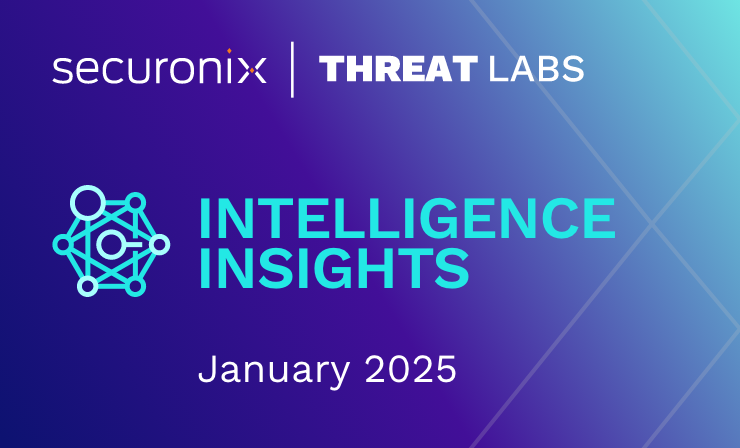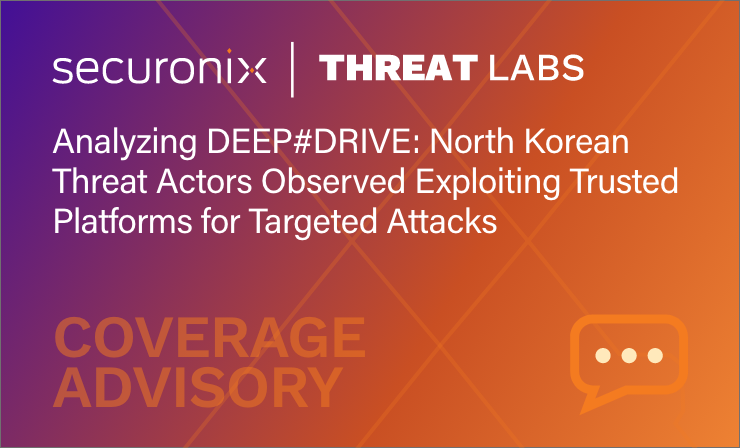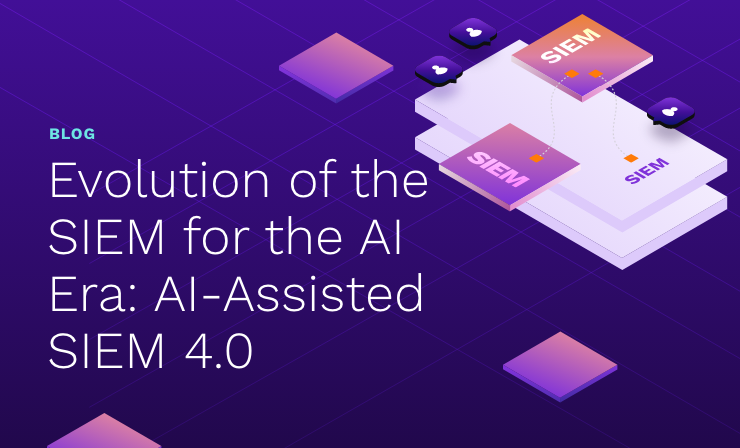- Why Securonix?
- Products
-
- Overview
- 'Bring Your Own' Deployment Models
-
- Products
-
- Solutions
-
- Monitoring the Cloud
- Cloud Security Monitoring
- Gain visibility to detect and respond to cloud threats.
- Amazon Web Services
- Achieve faster response to threats across AWS.
- Google Cloud Platform
- Improve detection and response across GCP.
- Microsoft Azure
- Expand security monitoring across Azure services.
- Microsoft 365
- Benefit from detection and response on Office 365.
-
- Featured Use Case
- Insider Threat
- Monitor and mitigate malicious and negligent users.
- NDR
- Analyze network events to detect and respond to advanced threats.
- EMR Monitoring
- Increase patient data privacy and prevent data snooping.
- MITRE ATT&CK
- Align alerts and analytics to the MITRE ATT&CK framework.
-
- Resources
- Partners
- Company
- Blog
Threat Research
By Oleg Kolesnikov and Den Iuzvyk, Securonix Threat Research Team
Created: December 8, 2020
Last Updated: January 12, 2021
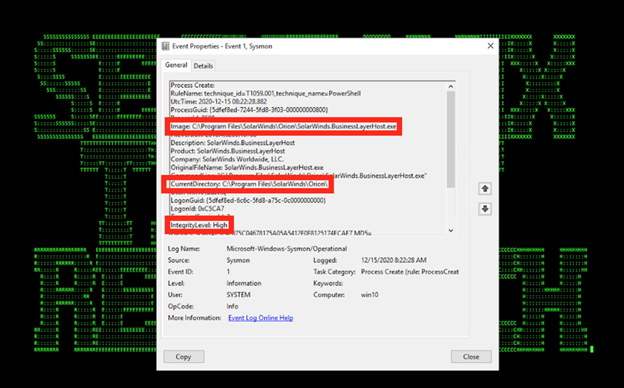
Figure 1: Example of Trojanized SolarWinds With Embedded Malicious Payload Activity in Logs
The Securonix Threat Research (STR) team has been actively investigating the critical ongoing SolarWinds Orion/SUNBURST supply chain attacks (monitored by STR as ECLIPSER) with some of the recent victims being one of the leading security vendors [1] as well as a number of US government entities and other victims targeted as part of attacks involving the compromised SolarWind Orion IT software [5,7].
Below is a summary of what we currently know about the high-profile SolarWinds Orion/ECLIPSER attacks and our recommendations on some possible Securonix predictive indicators/security analytics to increase your chances of detecting the current/future variants of the attacks involving the stolen tools as well as leveraging some of the known and unknown associated attack vectors/CVEs.
Update – January 12, 2021 – According to our latest analysis results and the publicly available details, there is a possibility that the SUNBURST/ECLIPSER breach involved a *broader/multi-stage* supply chain attack with potentially some of the tertiary supply chain vendor (JetBrains) build process components, such as, e.g. TeamCity CI/CD with some additional malicious implants possibly leveraging a variant of SUNSPOT [20] to enable backdooring of the main supply chain vendor
target (SolarWinds).
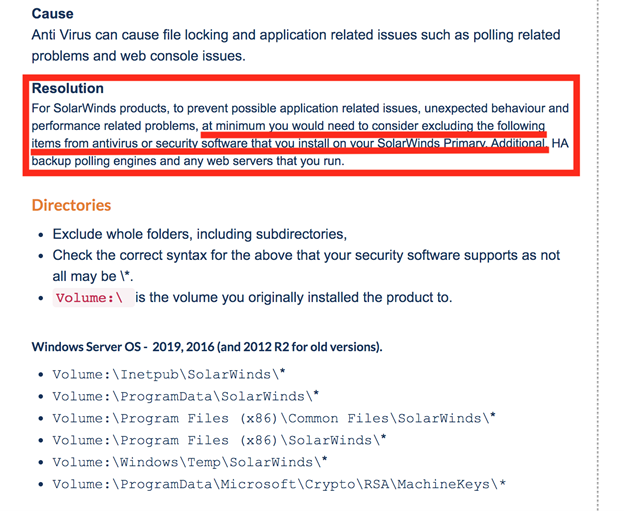
Figure 2: Attackers Taking Advantage of EDR/AV Monitoring Blind Spot – SolarWinds Advisory Recommending Excluding SolarWinds Components From EDR/AV Monitoring To Prevent Application-Related Issues [6,8]
Summary
Attack Vector(s): A covert multi-stage supply-chain attack with a longer breakout time/operational tempo (likely started prior to 2020) reportedly carried out by a nation-state-sponsored actor using a trojanized digitally-signed SolarWinds Orion IT monitoring component payload (SolarWinds.Orion.Core.BusinessLayer.dll)[5] and actively taking advantage of EDR/AV blind spots (See Figure 2)[6,8].
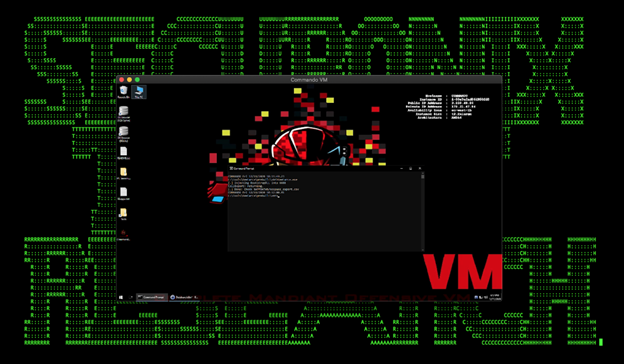
Figure 3: Example of One of SolarWinds Orion Attacks Victim’s Red Team Tools (KeeFarce) Reportedly Stolen by Attackers in Action
Impact: 18,000+ customers of SolarWinds believed to have been likely exposed as victims through compromised updates, including some major U.S. government (U.S. Treasury and Commerce, etc.), consulting (a leading US-based security company–FireEye/over 60 Red Team Tools (RTT) stolen by the MTA, etc.), technology, telecom, and other entities across North America, Europe, Asia, and the Middle East.
Some Examples of Observed ATT&CK Techniques:
- T1195.002 Supply Chain Compromise
- T1568.002 Dynamic Resolution: Domain Generation Algorithms
- T1497.003 Virtualization/Sandbox Evasion: Time Based Evasion
- T1027.003 Obfuscated Files or Information: Steganography
- T1041 Exfiltration Over C2 Channel
- T1583.003 Acquire Infrastructure: Virtual Private Server
- T1071.001 Application Layer Protocol: Web Protocols
- T1569.002 System Services: Service Execution
- T1070.004 Indicator Removal on Host: File Deletion
- T1057 Process Discovery
- T1036.003 Masquerading: Rename System Utilities
- T1021 Remote Services
- T1036.004 Masquerading: Masquerade Task or Service
-
T1101.001 Password guessing
-
T1101.003 Password spraying
-
T1078 Inappropriately secured administrative credentials
-
T1133 External remote access services
- T1053.005 Scheduled Task
*** Note that there were some new MITRE ATT&CK procedures and technique variants observed as part of the attacks. Some of the new procedural variations of techniques included, for instance, T1070 Indicator Removal on Host. In addition, some techniques were used as part of an expanded tscope such as T1098.001 Account Manipulation: Additional Cloud Credentials; there were also some new sub-techniques not yet published as part of ATT&CK, including T1606.002 Forge Web Credentials: SAML Tokens, and others [13].
Red Team Tools (RTT) Impact: From the analysis of the RTT stolen from one of the victims [1]:
>40% of the stolen RTT are either publicly available security tools or based on publicly available security tools (see Figure 3).
~40% of stolen RTT are developed internally by FireEye.
>15% of stolen RTT are difficult to identify because the details shared are very limited. Based on the details available, there is a high probability most of the tools are modified versions of the publicly available tools [3].
Scope:According to the sources familiar with the investigation, the breaches observed, including the recently disclosed attack stealing internal adversary/red team tools from a victim company (FireEye), are currently believed to be a part of a broader attack campaign leveraging a relatively sophisticated supply chain attack using SolarWinds Orion with a nation-state-sponsored malicious threat actor (MTA) taking advantage of compromised Solarwinds dev/prod. digital certificates (from March-May 2020) to sign a malicious trojanized update for SolarWinds® Orion® Platform software builds for versions 2019.4 HF 5 and 2020.2 with no hotfix or 2020.2 HF 1 & leveraging stolen SAML token signing certificate [7,10].
Update – In addition to the SUNBURST/ECLIPSER supply chain attacks, there’s been reports of additional malware referred to by some sources as SUPERNOVA. According to the available details [15], the malware is not part of the SUNBURST/ECLIPSER supply chain attacks and was instead separately placed on the targets using an SolarWinds Orion API zero-day authentication bypass vulnerability (CVE-2020-10148). The attacks reportedly involved using the vulnerabilities to install a custom unsigned trojanized DLL web shell implant “app_web_logoimagehandler.
Zero-day Exploits: According to one of the victims targeted by the malicious attackers (FireEye), *no zero-day exploits* were stolen. However, there were 16 CVE associated with the stolen RTT.
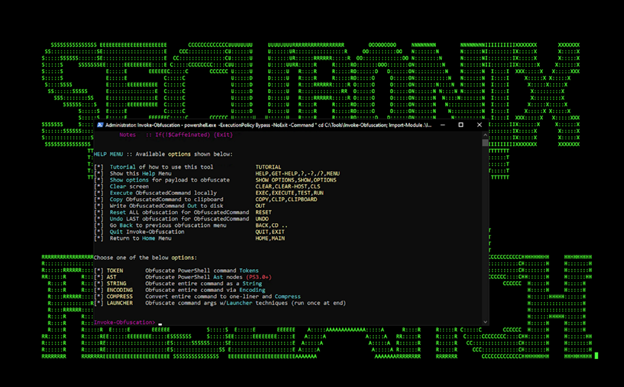
Figure 4: Example of a Variant of One of Victim’s Stolen Red Team Tools Available as Part of Public Sources (Rubeus)
Some of the Key Artifacts Observed:
e1ebab8ed84dc10b95a1f68c812ecb
5e643654179e8b4cfe1d3c1906a90a
fd15760abfc0b2537b89adc65b1ff3
2f1a5a7411d015d01aaee453583540
395da6d4f3c890295f7584132ea73d
75af292f34789a1c782ea36c7127bf
d130bd75645c2433f88ac03e73395f
ebe711516d0f5cd8126f4d53e375c9
0548eedb3d1f45f1f9549e09d00683
1b476f58ca366b54f34d714ffce3fd
2dafddbfb0981c5aa31f27a298b9c8
e70b6be294082188cbe0089dd44dbb
393702fab1c5d09d9f94e8a6311474
e18a6a21eb44e77ca8d739a72209c3
56ceb6d0011d87b6e4d7023d7ef856
846e27a652a5e1bfbd0ddd38a16dc8
3e329a4c9030b26ba152fb602a1d58
02af7cec58b9a5da1c542b5a32151b
2c4a910a1299cdae2a4e55988a2f10
f6d07f3d81dcea99b27462d1004149
2b3445e42d64c85a5475bdbc88a50b
6e4050c6a2d2e5e49606d96dd2922d
92bd1c3d2a11fc4aba2735d9547bd0
a25cadd48d70f6ea0c4a241d99c524
a3efbc07068606ba1c19a7ef21f4de
a58d02465e26bdd3a839fd90e4b317
ac1b2b89e60707a20e9eb1ca480bc3
b820e8a2057112d0ed73bd7995201d
b8a05cc492f70ffa4adcd446b693d5
ffdbdd460420972fd2926a7f460c19
c15abaf51e78ca56c0376522d699c9
019085a76ba7126fff22770d71bd90
c09040d35630d75dfef0f804f320f8
c15abaf51e78ca56c0376522d699c9
cc082d21b9e880ceb6c96db1c48a03
ce77d116a074dab7a22a0fd4f2c1ab
d0d626deb3f9484e649294a8dfa814
d3c6785e18fba3749fb785bc313cf8
dab758bf98d9b36fa057a66cd02847
e0b9eda35f01c1540134aba9195e7e
eb6fab5a2964c5817fb239a7a5079c
0f5d7e6dfdd62c83eb096ba193b5ae
1817a5bf9c01035bcf8a975c9f1d94
20e35055113dac104d2bb02d4e7e33
*.avsvmcloud\.com
*.lcomputers\.com
*.webcodez\.com
13.57.184.217
13.59.205.66
18.217.225.111
18.220.219.143
196.203.11.89
3.16.81.254
3.87.182.149
3.87.182.149
34.219.234.134
54.193.127.66
54.215.192.52
0548eedb3d1f45f1f9549e09d00683
1b476f58ca366b54f34d714ffce3fd
2dafddbfb0981c5aa31f27a298b9c8
e70b6be294082188cbe0089dd44dbb86e365f6a2
02af7cec58b9a5da1c542b5a32151ba1
fd15760abfc0b2537b89adc65b1ff3f072e7e31c
20e35055113dac104d2bb02d4e7e33
2b3445e42d64c85a5475bdbc88a50b
0f5d7e6dfdd62c83eb096ba193b5ae
1817a5bf9c01035bcf8a975c9f1d94
6e4050c6a2d2e5e49606d96dd2922d
92bd1c3d2a11fc4aba2735d9547bd0
a3efbc07068606ba1c19a7ef21f4de
a58d02465e26bdd3a839fd90e4b317
b820e8a2057112d0ed73bd7995201d
b8a05cc492f70ffa4adcd446b693d5
cc082d21b9e880ceb6c96db1c48a03
e0b9eda35f01c1540134aba9195e7e
ffdbdd460420972fd2926a7f460c19
ervsystem\.com
infinitysoftwares\.com
mobilnweb\.com
5f40b59ee2a9ac94ddb6ab9e3bd776
c45c9bda8db1d470f1fd0dcc346dc4
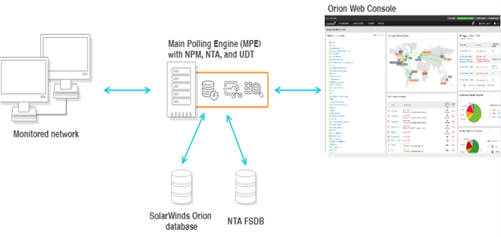
Figure 5: Example of a “Watcher” – SolarWinds Orion Monitoring Architecture
Critical SolarWinds ECLIPSER aka SUNBURST aka Solorigate Attacks – Blue Team Highlights
Detection Highlight #1 – Importance of “Watching the Watchers” (WOW) Detections
SolarWinds Orion (SO) is one of the common “Watcher” products that can be used to help IT/ops monitor the health and performance of an infrastructure.
At the same time, there often is very limited/no security monitoring done of the orgs’ “Watcher” products themselves, whether on a network, security, or in the cloud.
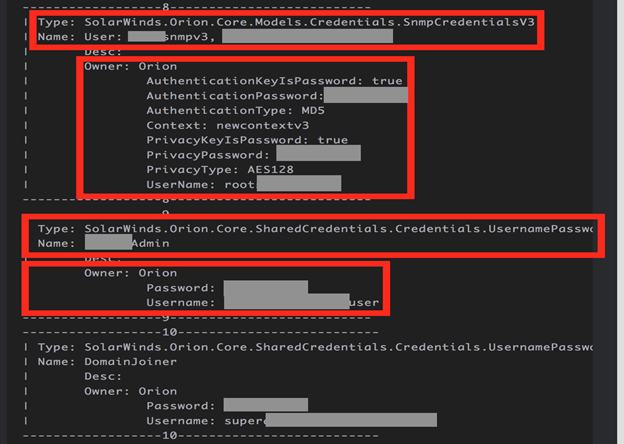
Figure 6: Sensitive Details Likely Dumped by Attackers Directly From SolarWinds Orion DB
As we’ve seen with the critical SO attacks, this lack of monitoring can represent a significant security detection gap that can be effectively exploited by attackers.
This is particularly critical in light of the fact that SO stored sensitive credentials in its internal DB that can be dumped, e.g. using open source tools such as SolarFlare from mubix [11], and others.
This type of credential dumping was also likely leveraged by the attackers as part of the lateral movement within the victims’ networks and potentially means that a number of other SO-controlled components might have been compromised (see Figure 6).
In order to address this major detection gap, it is critical to include the WOW detection use cases and security monitoring as part of your detection-in-depth strategy.
This includes security monitoring of your IT/Ops tools, your network appliance and edge devices, your virtual and cloud services, the related cloud/applications/logs, et al.
For some examples of the relevant detections, please see below.
Detection Highlight #2 – AV/EDR Blind Spots and Importance of Diversifying Your Telemetry (DYT)
Another important highlight from the latest attacks targeting SO relates to how effectively the attackers exploited the common *AV/EDR blind spots*.
Specifically, as shown in Figure 2, AV/EDR was explicitly recommended by the vendor/SO to be *disabled* to prevent application-related issues.
This approach is not uncommon across many vendors/organizations with some of the products often just added to whitelists with minimal SOC deconflicting/investigations.
This was combined with some additional EDR evasion/covertness w/relatively higher level of opsec behaviors [10] enabling attackers to remain undetected/evade EDR longer.
One of the key takeaways from these attacks is the importance of not relying on a single telemetry source such as EDR, NTA, logs, etc.
To detect the modern attacks, it is critical to be able to leverage multiple diversified telemetry (DYT) data sources as part of your detections, e.g. your IT/Ops tools, your network appliance and edge devices, your endpoints, your critical servers, firewall/proxies, virtual and cloud services, the related cloud/applications/logs, etc.
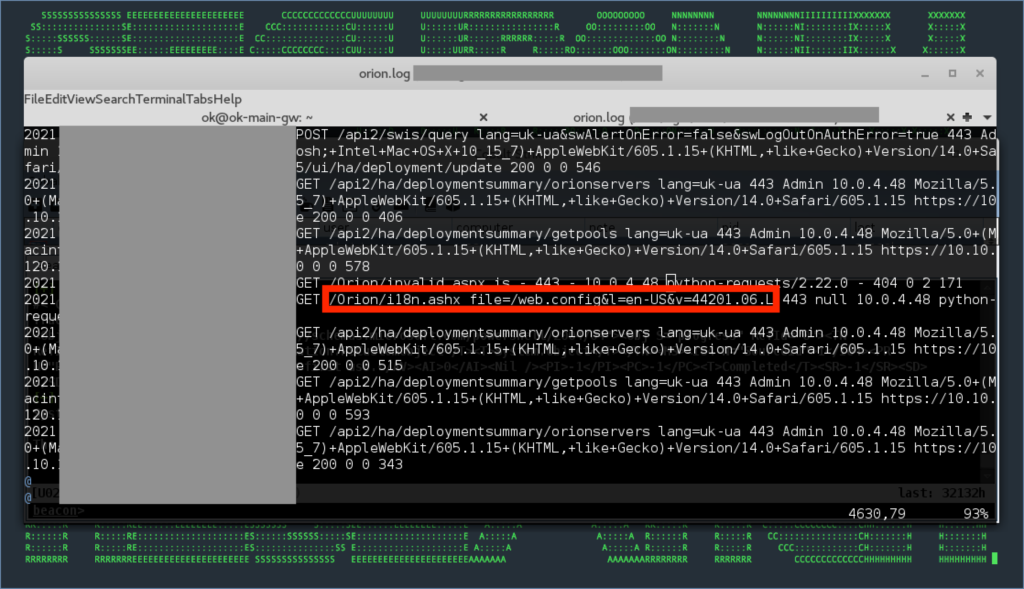
Figure 6.1: SUPERNOVA – Some Examples of Additional SolarWinds Exploitation Attempts In Logs
Detection – Sample Spotter Search Queries – SolarWinds/ECLIPSER Malicious Activity
Please find below some examples of the trivial Spotter queries to assist with initial threat hunting/retrohunting/identifying some possible attack behaviors based on the details above.
Note: Because of the rapidly changing attack landscape, the recommendation is not to rely on static IOAs/queries and to implement the use cases/predictive indicators for the best possible protection (see next section).
### Proxy
rg_functionality = “Web Proxy” and destinationhostname not contains “.solarwinds.com” and (RequestUrl contains “/swip/upd/SolarWinds.CortexPlugin.Components.xml” or RequestUrl contains “/swip/Events” or RequestUrl contains “swip/Upload.ashx”)
### Named Pipes
rg_functionality = “Endpoint Management Systems” and (baseeventid=17 or baseeventid=18) and filepath contains “583da945-62af-10e8-4902-a8f205c72b2e”
### Process Monitoring
rg_functionality =”Endpoint Management Systems” AND (oldfilename CONTAINS “SolarWinds. BusinessLayerHost.exe” or oldfilename CONTAINS “SolarWinds.BusinessLayerHostx64.exe”) AND (filename IS NOT NULL AND filename !=”-“) | RARE filename
### Cloud/AzureAD – New Credential Added by Admin/App Owner to An Application/SP
rg_functionality = “MicrosoftAzureActiveDirectoryAuditLogs” AND customstring3 IN (“Add service principal”, “Certificates and secrets management”)
AND eventoutcome CONTAINS “success” AND (InitiatedBy.user.userPrincipalName CONTAINS “@” OR InitiatedBy.app.displayName CONTAINS “@”)
AND (keyEvents CONTAINS “KeyIdentifier=” AND keyEvents CONTAINS “KeyUsage=Verify”)
AND keyEvents.displayName CONTAINS “KeyDescription”
AND (keyEvents.oldValue = “[]” OR keyIdentifier != keyIdentifierOld)
AND keyUsage = “Verify”
### Cloud/AzureAD – Users Signing Into AzureAD via PS Accessing Non-AD
Resources [10]
rg_functionality = “MicrosoftAzureSigninLogs” AND AppId CONTAINS
“1b730954-1685-4b74-9bfd-
“AzureAD”
AND ResourceIdentity != “00000002-0000-0000-c000-
rg_functionality = “Microsoft Windows” AND destinationprocessname ENDS
WITH “powershell.exe”
AND (
resourcecustomfield1 CONTAINS ‘powershell -nop -w hidden -enc ‘
OR resourcecustomfield1 CONTAINS ‘powershell -nop -exec bypass -enc ‘
)
rg_functionality = “Microsoft Windows” AND destinationprocessname NOT
ENDS WITH “msbuild.exe” AND resourcecustomfield1 NOT CONTAINS
‘msbuild’
AND (
resourcecustomfield1 CONTAINS ‘noconsolelogger’
OR resourcecustomfield1 CONTAINS ‘noconlog’
)
rg_functionality = “Microsoft Windows” AND destinationprocessname ENDS
WITH “dism.exe”
AND (
resourcecustomfield1 CONTAINS “/Mount-Wim”
OR resourcecustomfield1 CONTAINS “/WimFile:”
OR resourcecustomfield1 CONTAINS “/MountDir:”
OR resourcecustomfield1 CONTAINS “/LogPath:NUL”
OR resourcecustomfield1 CONTAINS “/index:1”
)
### Process Hashes [4]
rg_functionality = “Endpoint Management Systems” AND baseeventid=7 AND sourceProcessName CONTAINS “svchost.exe” AND destinationProcessName ENDS WITH “NetSetupSvc.dll”
rg_functionality = “Endpoint Management Systems” AND (baseeventid=1 OR baseeventid = 4688) AND filehash in (“b91ce2fa41029f6955bff20079468448”, “02af7cec58b9a5da1c542b5a32151ba1″,”2c4a910a1299cdae2a4e55988a2f102e”, “846e27a652a5e1bfbd0ddd38a16dc865”, “4f2eb62fa529c0283b28d05ddd311fae”, “56ceb6d0011d87b6e4d7023d7ef85676”)
### Proxy C2 [4]
rg_functionality = “Web Proxy” and RequestUrl in (“panhardware.com”,”databasegalore.com”,”avsvmcloud.com”,”freescanonline.com”,”thedoccloud.com”,”deftsecurity.com”)
### Some Trivial SO-related Process Insights For Threat Hunting
rg_functionality = “Endpoint Management Systems” AND (baseeventid=1 OR baseeventid = 4688) AND sourceprocessname=”solarwinds.businesslayerhost.exe”
AND destinationProcessName NOT ENDS WITH “\SolarWinds\Orion\ExportToPDFCmd.exe”
AND destinationProcessName NOT ENDS WITH “\SolarWinds.Credentials\SolarWinds.Credentials. Orion.WebApi.exe”
AND destinationProcessName NOT ENDS WITH “\SolarWinds\Orion\Topology\SolarWinds.Orion.Topology.Calculator.exe”
AND destinationProcessName NOT ENDS WITH “\SolarWinds\Orion\\Database-Maint.exe”
AND destinationProcessName NOT ENDS WITH “\SolarWinds.Orion.ApiPoller.Service\SolarWinds.Orion.ApiPoller.Service.exe”
AND destinationProcessName NOT ENDS WITH “\Windows\SysWOW64\WerFault.exe”
rg_functionality = “Endpoint Management Systems” AND sourceprocessname
ENDS WITH “SolarWinds.BusinessLayerHost.
destinationprocessname ENDS WITH “powershell.exe”
rg_functionality = “Endpoint Management Systems” AND sourceprocessname
ENDS WITH “SolarWinds.BusinessLayerHost.
destinationprocessname ENDS WITH “cmd.exe” AND resourcecustomfield1
CONTAINS “echo”
rg_functionality = “Endpoint Management Systems” AND sourceprocessname
ENDS WITH “Microsoft.IdentityServer.
(destinationprocessname ENDS WITH “werfault.exe” OR
destinationprocessname ENDS WITH “csc.exe”) AND resourcecustomfield1
NOT CONTAINS “nameId”
rg_functionality = “Endpoint Management Systems” AND
destinationpocessname ENDS WITH “csrss.exe” AND filepath NOT STARTS
WITH “C:\Windows\System32”
rg_functionality = “Endpoint Management Systems” AND
destinationpocessname NOT ENDS WITH “adfind.exe” AND
resourcecustomfield1 CONTAINS ” -h ” AND resourcecustomfield1 CONTAINS
” -f ” AND ((resourcecustomfield1 CONTAINS “name=” AND
resourcecustomfield1 CONTAINS “Domain Admins” AND resourcecustomfield1
CONTAINS “member” AND resourcecustomfield1 CONTAINS “-list”) OR
(resourcecustomfield1 CONTAINS “objectcategory=”)
rg_functionality = “Windows Powershell” AND baseeventid = 4104 and
message CONTAINS “ComObject” AND message CONTAINS “Schedule.Service”
AND message CONTAINS “Microsoft\Windows\
AND message CONTAINS “RegisterTaskDefinition” AND message CONTAINS
“EventCacheManager.exe” AND message CONTAINS “ONSTART”
### Cloud/AzureAD – Users Signing Into AzureAD via PS Accessing Non-AD
Resources [10]
rg_functionality = “MicrosoftAzureSigninLogs” AND AppId CONTAINS
“1b730954-1685-4b74-9bfd-
“AzureAD”
AND ResourceIdentity != “00000002-0000-0000-c000-
filehash NOT NULL AND filehash in
(“
“
“
“
“
“
“
“
“
filehash NOT NULL AND filehash in
(“
ce77d116a074dab7a22a0fd4f2c1ab
0f5d7e6dfdd62c83eb096ba193b5ae
e0b9eda35f01c1540134aba9195e7e
20e35055113dac104d2bb02d4e7e33
2b3445e42d64c85a5475bdbc88a50b
a3efbc07068606ba1c19a7ef21f4de
92bd1c3d2a11fc4aba2735d9547bd0
a58d02465e26bdd3a839fd90e4b317
cc082d21b9e880ceb6c96db1c48a03
0f5d7e6dfdd62c83eb096ba193b5ae
e0b9eda35f01c1540134aba9195e7e
20e35055113dac104d2bb02d4e7e33
2b3445e42d64c85a5475bdbc88a50b
a3efbc07068606ba1c19a7ef21f4de
92bd1c3d2a11fc4aba2735d9547bd0
a58d02465e26bdd3a839fd90e4b317
cc082d21b9e880ceb6c96db1c48a03
Detection – Sample Spotter Search Queries – Related Attack Vectors/CVEs
Please find below some examples of the trivial Spotter queries to assist with detection of some of the related CVEs disclosed [1].
Note: Because of the rapidly changing attack landscape, the recommendation is not to rely on static IOAs/queries and to implement the use cases/predictive indicators for the best possible protection (see next section).
Some sample Spotter search queries to assist with detection of the use of the relevant attack vectors/CVEs disclosed by some of the victims, e.g. FireEye, are as follows:
### CVE-2019-11510
rg_functionality = “Web Proxy” and RequestUrl CONTAINS “?/dana/html5acc/guacamole/”
### CVE-2018-13379
rg_functionality = “Web Proxy” and RequestUrl contains “/remote/fgt_lang?lang=/../../../..////////// dev/cmdb/sslvpn_websession”
### CVE-2020-1472
resourcegroupname= “zeek” AND sourcetype=bro:rpc:json operation IN (NetrServerReqChallenge, NetrServerAuthenticate3, NetrServerPasswordSet2)
| STATS count by sourceaddress
| where count > 100
### CVE-2019-11580
rg_functionality = “Web Proxy” and RequestUrl CONTAINS “/crowd/plugins/servlet/exp?cmd=”
### CVE_2019-19781
rg_functionality = “Web Proxy” and RequestUrl CONTAINS “/../vpns/” or RequestUrl CONTAINS “/vpns/cfg/smb.conf” or (RequestUrl CONTAINS “/vpns/portal/scripts/” and RequestUrl CONTAINS “.pl”)
### CVE-2020-10189
rg_functionality = “Endpoint Management Systems” AND (baseeventid=1 OR baseeventid = 4688) AND sourceprocessname ENDS WITH “DesktopCentral_Server\ jre\bin\java.exe” and (destinationprocessname ENDS WITH “cmd.exe” or destinationprocessname ENDS WITH “powershell.exe” or destinationprocessname ENDS WITH “bitsadmin.exe”)
and others.
Detection – Sample Spotter Search Queries – Red Team Tools
Please find below some examples of the trivial Spotter queries to assist with initial threat hunting/identifying some behaviors associated with the stolen RTT [4].
Note: Because of the rapidly changing attack landscape, the recommendation is not to rely on static IOAs/queries and to implement the use cases/predictive indicators for the best possible protection (see next section).
rg_functionality = “Endpoint Management Systems” AND baseeventid = 7 AND filepath ENDS WITH “libvlc.dll”
rg_functionality = “Microsoft Windows” AND filename IN (‘\PIPE\OIPC_CNTAOSMGR_PIPE_2218EBAB_63F8_##E4_930C_AF69E78928AF’, ‘\PIPE\OIPC_OFC_AS_PIPE_2218EBAB_63F8_49E4_93##_AF69E79928AF’, ‘\Device\Mup\’)
“rg_functionality = “Microsoft Windows” AND destinationprocessname ENDS WITH “powershell.exe” AND (additionaldetails1 CONTAINS ‘powershell -nop -w hidden -enc ‘ OR additionaldetails1 CONTAINS ‘powershell -nop -exec bypass -enc ‘)
rg_functionality = “Microsoft Windows” AND destinationprocessname NOT ENDS WITH “msbuild.exe” AND additionaldetails1 NOT CONTAINS ‘msbuild’ AND (OR additionaldetails1 CONTAINS ‘noconsolelogger’ OR additionaldetails1 CONTAINS ‘noconlog’) AND (sourceprocessname NOT ENDS WITH ‘\bin\nact.exe’ OR sourceprocessname NOT ENDS WITH ‘\MSBuild\15.0\Bin\amd64\Tracker.exe’ OR sourceprocessname NOT ENDS WITH ‘\Program Files\dotnet\dotnet.exe’)
rg_functionality = “Endpoint Management Systems” AND baseeventid = 7 AND (filepath ENDS WITH “anything. cpl” OR filepath ENDS WITH “\anything.dll”)
rg_functionality = “Endpoint Management Systems” AND baseeventid = 7 AND (filepath ENDS WITH “anything. cpl” OR filepath ENDS WITH “\anything.dll”)
rg_functionality = “Endpoint Management Systems” AND baseeventid = 7 AND filepath ENDS WITH ‘”ibvlc.dll”
rg_functionality = “Endpoint Management Systems” AND baseeventid = 7 AND filepath ENDS WITH “X32BRIDGE.dll”
rg_functionality = “Microsoft Windows” AND destinationprocessname ENDS WITH “excolorcplcavator.exe”
AND (sourceprocessname ENDS WITH “cscript.exe” OR sourceprocessname ENDS WITH “wscript.exe” OR sourceprocessname ENDS WITH “MSHTA.exe” OR sourceprocessname ENDS WITH “winword.exe” OR sourceprocessname ENDS WITH “excel.exe”)
rg_functionality = “Microsoft Windows” AND (destinationprocessname ENDS WITH “colorcpl.exe” OR destinationprocessname ENDS WITH “colorcpl.exe”) AND (sourceprocessname ENDS WITH “cscript.exe” OR sourceprocessname ENDS WITH “wscript.exe” OR sourceprocessname ENDS WITH “MSHTA.exe”)
rg_functionality = “Microsoft Windows” AND destinationprocessname ENDS WITH “dism.exe” AND (additionaldetails1 CONTAINS “/Mount-Wim” OR additionaldetails1 CONTAINS “/WimFile:” OR additionaldetails1 CONTAINS “/MountDir:” OR additionaldetails1 CONTAINS “/LogPath:NUL” OR additionaldetails1 CONTAINS “/index:1”)
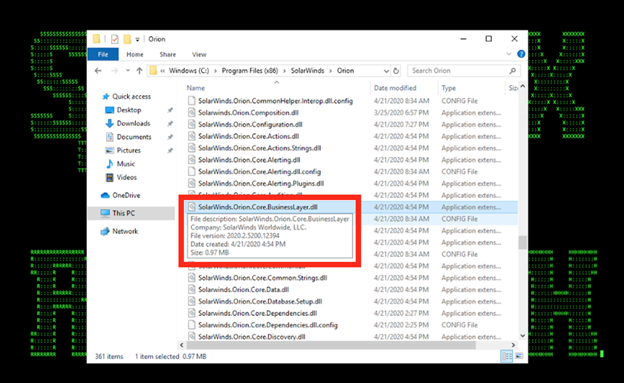
Figure 7: Example of Malicious Compromised DLL Loaded by the Target SolarWinds Instance
Detection – Securonix Behavior Analytics/Security Analytics
Here are some high-level examples of some of the relevant Securonix behavior analytics/predictive indicators to increase the chances of early detection of the malicious activity associated with the SolarWinds/ECLIPSER MTA including potential future variants of attacks:
- Watching the Watchers (WOW) – Possible Trojaned Vendor HTTP C2 Behavior Discrepancy Analytic
- Possible SolarWinds Orion DB Credential Dumping Using SOLARFLARE
- Possible ADPassHunt Malicious Payload Use Analytic
- Traffic to DGA Domains – Possible C2 Analytic
- Possible TEARDROP Malicious Payload Variant Analytic
- Possible Renamed LOL Helper Tool Payload Use By Malware Analytic
- Possible SUNSPOT Variant Dropped Artifact Analytic
- Rare WMI Exec Process Potential Lateral Movement Analytic
- Peak DNS IN A Request Volume For Source Analytic
- Possible Zerologon CVE-2020-1472 EP Computer Account Change Analytic
- Possible SolarWinds SUPERNOVA Auth Bypass Exploitation Analytic
- Possible Malicious .NET CSC.EXE Implant In-Memory Compilation Analytic
- Possible SolarWinds SUPERNOVA i18n Malicious Activity Analytic
- Watching the Watchers (WOW) – Possible Compromised Vendor Component Rare JA3 C2 Hash Analytic
and a number of others, including WOW-PXY1-ERI, WEL-TAR45-RUN, WOW-EDR1-ERI, WOW-EDR2-ERI, WOW-NTA1-ERI, EDR-SYM111-ERI, EDR-SYM112-RUN, DNS-BIN1-BPI, and others.
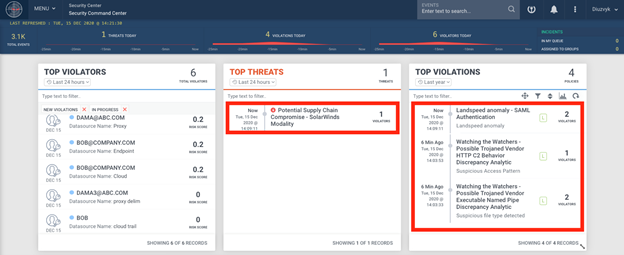
Figure 8: Example of SolarWinds/ECLIPSER Detection in Securonix Labs
Mitigation and Prevention – Securonix Recommendations
Here are some of the Securonix recommendations to help customers prevent and/or mitigate future attacks:
- Follow the mitigation guidance depending on your network categorization as specified in AA20-352A [19].
- If running the affected versions, conduct forensic analysis, and if accepting the risk of running the affected product, perform hardening as described in ED-21-01 [18].
- Consider performing an in-depth security review of your on-prem and cloud infrastructure for possible post-breach persistence vectors embedded by the attackers.
- In the event of a likely systemic identity compromise, consider performing a partial or full reconstitution of your IAM/trust services to mitigate the risks of reoccurrence.
- Proactively validate and configure the missing logging visibility/security monitoring to ensure that all the relevant logs, including:
-
- Remote access (VPN, RDP, SSH, et al.) logs
- Solarwinds platform/IIS logs
- IDP/SP/Cloud access logs
- Authentication/MFA logs
- Endpoint (raw)/AD/server logs, NTA logs, etc.
are captured and stored for at least 180-270 days in a separate log capability.
- For all network devices (routers, switches, firewalls, etc.) managed by affected SolarWinds servers, consider auditing firmware and configurations for possible signs of subversion/backdooring and resetting to a stable firmware, if feasible.
References
[1] Kevin Mandia. FireEye Shares Details of Recent Cyber Attack, Actions to Protect Community. December 8, 2020. https://www.fireeye.com/blog/products-and-services/2020/12/fireeye-shares-details-of-recent-cyber-attack-actions-to-protect-community.html
[2] Kolesnikov et al. Securonix Threat Research: Detecting High-Impact Targeted Cloud/MSP $14M+ Ryuk and REvil Ransomware Attacks. January 3, 2020. https://www.picussecurity.com/resource/blog/techniques-tactics-procedures-utilized-by-fireeye-red-team-tools.
[3] Özarslan et al. Tactics, Techniques and Procedures (TTPs) Utilized by FireEye’s Red Team Tools. December 10, 2020. https://www.picussecurity.com/resource/blog/techniques-tactics-procedures-utilized-by-fireeye-red-team-tools.
[4] FireEye Countermeasures. December 8, 2020. https://github.com/fireeye/red_team_tool_countermeasures.
[5] FireEye. Highly Evasive Attacker Leverages SolarWinds Supply Chain to Compromise Multiple Global Victims With SUNBURST Backdoor. December 13, 2020. https://www.fireeye.com/blog/threat-research/2020/12/evasive-attacker-leverages-solarwinds-supply-chain-compromises-with-sunburst-backdoor.html.
[6] SolarWinds. Files and directories to exclude from antivirus scanning for Orion Platform products (AV exceptions and exclusions). https://support.solarwinds.com/SuccessCenter/s/article/Files-and-directories-to-exclude-from-antivirus-scanning-for-Orion-Platform-products?language=en_US
[7] Christopher Bing. Reuters – Suspected Russian hackers spied on U.S. Treasury emails – sources. December 13, 2020. https://www.reuters.com/article/us-usa-cyber-treasury-exclsuive/exclusive-u-s-treasury-breached-by-hackers-backed-by-foreign-government-sources-idINKBN28N0PG
[8] Ozarslan. December 15, 2020. Tactics, Techniques, and Procedures (TTPs) Used in the SolarWinds Breach. https://www.picussecurity.com/resource/blog/ttps-used-in-the-solarwinds-breach.
[9] John Lambert. Important steps for customers to protect themselves from recent nation-state cyberattacks. December 13, 2020. https://blogs.microsoft.com/on-the-issues/2020/12/13/customers-protect-nation-state-cyberattacks/
[10] MSRC. Customer Guidance on Recent Nation-State Cyber Attacks. December 13, 2020. https://msrc-blog.microsoft.com/2020/12/13/customer-guidance-on-recent-nation-state-cyber-attacks/.
[11] Mubix. SolarFlare Release: Password Dumper for SolarWinds Orion. December 13, 2020. https://malicious.link/post/2020/solarflare-release-password-dumper-for-solarwinds-orion/.
[12] Brain Krebs. U.S. Treasury, Commerce Depts. Hacked Through SolarWinds Compromise. December 14, 2020. https://krebsonsecurity.com/2020/12/u-s-treasury-commerce-depts-hacked-through-solarwinds-compromise/.
[13] Damien Cash et al. Dark Halo Leverages SolarWinds Compromise to Breach Organizations. December 14, 2020. https://www.volexity.com/blog/2020/12/14/dark-halo-leverages-solarwinds-compromise-to-breach-organizations/.
[14] Malone M. et al. Identifying UNC2452-Related Techniques for ATT&CK. January 6, 2020.
https://medium.com/mitre-
[15] SolarWinds. SolarWinds Security Advisory. December 31, 2020. https://www.solarwinds.com/
[16] Perlroth N. et al. Widely Used Software Company May Be Entry Point for Huge U.S. Hacking. January 6, 2021. https://www.nytimes.com/2021/
[17] FBI, CISA, ODNI, NSA. Joint Statement. January 5, 2021. https://www.cisa.gov/news/
[18] CISA. Supplemental Guidance v3. January 6, 2021. https://cyber.dhs.gov/ed/21-
[19] CISA. Advanced Persistent Threat Compromise of Government Agencies, Critical Infrastructure, and Private Sector Organizations. January 7, 2021. https://us-cert.cisa.gov/ncas/
[20] Crowdstrike. SUNSPOT: An Implant in the Build Process. January 12, 2021. https://www.crowdstrike.com/bl




